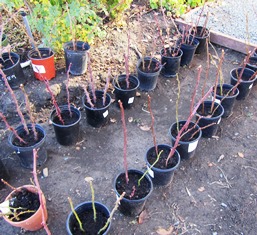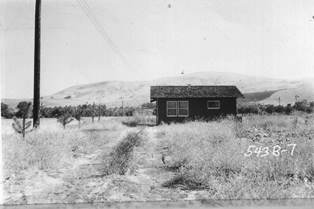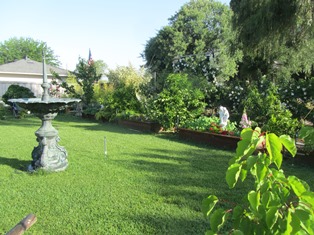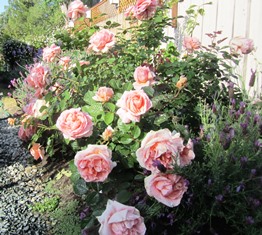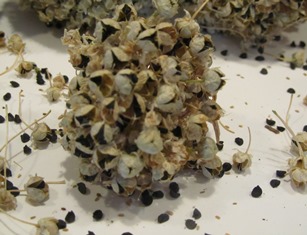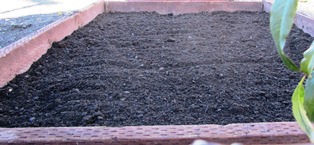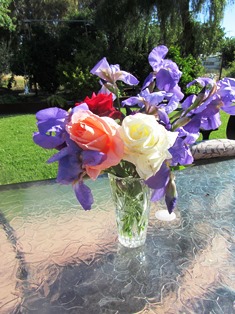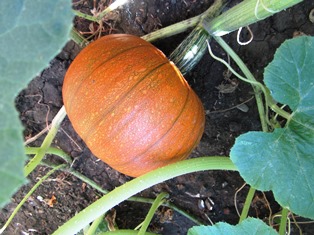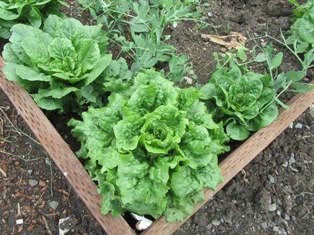Archive for the 'Plants and Trees' Category
Preparing for an Early Spring
It’s winter. The nights are cold and the early mornings even colder. But here on the farmette, daytime temps are still unseasonably warm for this time of year in Northern California. That makes doing all the winter cleanup and spring preparation chores not only tolerable, but enjoyable.
We’ve pruned all the roses and taken cuttings for propagation of new bushes that we’ll plant around our property. We’ve divided the irises and planted the babies in new beds. Finally, we tackled pruning the fruit trees and imagine how shocked we were to find our Desert Gold peach trees with buds ready to open. The reason must be the warm weather.
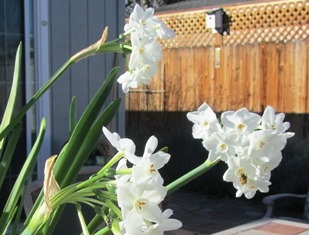
The honeybees are searching for blossoms and finding none, they’re exploring the papaperwhite narcissus on my patio table
The honeybees are searching for flowers in bloom. They’ve flown to the citrus trees that I’ve covered against nighttime freezing temps and are wandering about on the blankets. The French perfume lavender still has some blooms but the bees seem also interested in the paperwhite narcissus blooms that I forced in water between Christmas and New Years Day.
We’ve moved the strawberries to a newly prepared bed in two planter boxes and are revitalizing the soil in the old boxes. Bare root season is around the corner and my husband and I are feeling the pressure to get the garden ready for a new growing season. The days are lengthening and we don’t want an early spring to catch us unprepared. Technically, winter has only just begun but the birds and bees and buds on the trees are suggesting it could be a short winter.
The Farmette Renovation Work Continues through All Seasons
I met with the tax assessor last month and he gave me a picture of our small farmette house from 1953. At that time, the house was only six months old. Over the ensuing years, many changes were made, rendering the tiny miner’s shack or bunkhouse (that appears to have been a single room) into a 2-bedroom, 2 bath house of roughly 1,000 square feet. We continue to renovate but limited resources slows everything. Eventually, we’ll have a small finished house in a lovely environment.
When we found the property in 2009, it was in foreclosure and looked like a dump. That’s because it had been used as one. Broken pieces of granite and cabinetry wood had been piled along its aging, rotting fences, too weak and weary to remain upright. Inside, the hardwood floors had been ripped off and everything that could be “harvested” from the house by others had been taken. The only appliance was an old refrigerator sitting a weed-field that served as the back yard.
But we saw land all around. Rising up to the north in back of our farmette are hills (emerald green in the rainy season) that separate the inland valley where our farmette is located from the great Central Valley of California. Seeming as near as our front yard, the blue-green peaks of Mount Diablo tower over the landscape in the east and southeast (we now see these from our living room couch and front porch). From the northwest in summer, the breezes off the San Francisco Bay where it becomes the Straits of Carquinez blow toward Mount Diablo around 4:00 P.M. every day to cool the area.
After pulling out the weeds that at one point towered over our heads, we envisioned re-engineering everything. We constructed a new landscape that included fruit, citrus, and nut trees, beds for roses and other flowers, an heirloom herb and vegetable garden, and a designated area for bees and chickens.
Without a huge budget, we believed the renovation of the house would be ongoing (and it has been). This is our fourth winter. When we are not working outside, we are working on the renovation inside. For example, recently we installed window trim in the living room. Today, I’ll caulk, spackle, and sand in preparation for painting later this week.
Previously the entry into the house was through a side door and bathroom. The first impression wasn’t good. My husband created a welcoming entrance with exterior moldings around the windows and door. I talked him into a screen door and a porch (as yet unfinished) with a trellis to support purple wisteria.
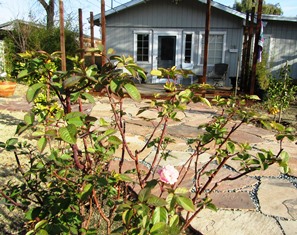
A flagstone path lined with roses and citrus trees leads to the new front door but the porch is yet to be finished
Since unseasonably warm temperatures have been forecast for the week, we have begun work on a flagstone walkway leading to the porch. I love when Carlos gets out string, stakes, and the can of marking spray and begins putting down boundaries for fences, walkways, stone paths, and garden gates. The tax assessor didn’t ask about those markings. But we expect the property value to be listed higher next year because of the renovation we’ve already done.
Salivating Over New Organics from Old and Rare Seed
What I love most about the onset of winter is the arrival of the seed catalogs. Armed with the newest one, I enjoy sitting on the porch, warming my bones under the pale winter sun, and reading about what I could be growing on the Henny Penny Farmette this spring–like the onions from rare, old seed that Bountiful Gardens offers in its 2014 catalog.
Bountiful Gardens is a nonprofit organization located in Willits, California (160 miles north of San Francisco). The organization has signed the Safe Seed Pledge and promises to never knowingly buy or sell seeds that are GMO (genetically modified).
The onion seed I’m eager to purchase is the Mill Creek Red Onion–a special heirloom I read about that is considered to be bolt-resistant and grows well in spring or fall. According to the catalog, the onion was bred by nursery owners Joe and Wanda Turi, who have since passed away. Thanks to the folks at Bountiful Gardens, a box of the Turi’s onions was acquired, ensuring the rare seed would be preserved and multiplied in gardens like mine and yours.
Another vegetable I want to try is the Early Purple Sprouting broccoli, a European heirloom that grows into a large plant with purple heads possessing excellent nutritional value and flavor. An August planting is recommended because the plant needs to survive through a winter to become productive.
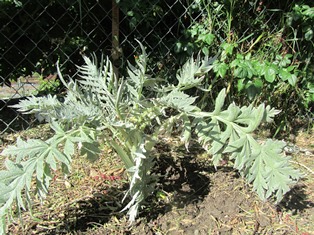
I managed not to kill the artichoke I planted last year and, thus encouraged, I would like to grow some other varieties
The artichoke (cynara cardynculus) listing in the catalog also intrigues me. The plant won’t produce chokes during its first year, but I don’t mind. Having an abundance of chokes for farmette meals makes me want to send for the seed right now. Don’t even get me started on all the herbs I want to order and plant! I might have to turn the farmette into a farm.
The Bountiful Gardens 2014 catalog is one of the best. Not only are the listings intriguing to read, the full-color pictures are nothing short of seductive for a gardener. Offerings include heirloom, open-pollinated, untreated seeds for sustainable growing of vegetables, grains, oil and forage crops, wild trees and shrubs, berries, herbs, and flower. The catalog even offers mushroom spawn. There are also books and media products available on gardening topics, composting, permaculture, self-sufficiency, garden pests, tools, seed saving, and much more.
If you are interested in getting your own copy of the 2014 catalog, write to Bountiful Gardens, 18001 Shafer Ranch Road, Willits, CA 95490; phone 707-459-6410. Or email: bountiful@sonic.net. See, http://www.bountifulgardens.org
Divide Irises to Regenerate the Plant and Get Spectacular Blooms
Dividing the rhizomes of bearded iris plants is an easy and necessary process as the plant ages. The division process is best done during late summer or early fall, but we are doing this job now on our farmette.
The rhizome is a thick tuberous type of structure that sends up stems and leaves and also produces roots. Many gardeners divide their iris clumps every three to four years. Our beds of iris have become overcrowded with many new baby plants. It’s time to divide.
Before we move our iris from the side garden to planter boxes made of pressure-treated redwood, we prepare the soil in those boxes. We amend it with low-nitrogen fertilizer and compost.

These iris are planted too close–they will be replanted to 16 inches apart for air to circulate and for growing room
We cut back the foliage and pull off any of the sword-shaped leaves that have dried. Then we gently pull apart the new growth from the old clump. Pruning and cutting back the leaves helps ensure that pests do not overwinter.
The rhizome produces more rhizomes over time. Eventually the original rhizome will wither and die. Regularly dividing the clumps ensures new baby plants and blooms for years to come.
Early December Farmette Chores
I arose early today as I have for the last few months, eager to greet the rising sun even as the days grow shorter as we head toward the winter solstice. I stand with eyes closed facing east until the light blazes against my lids, almost lighting my being from the inside. Then I say prayers–my way to start the day off right.
The fruit trees have changed leaf color and dropped most of their foliage. I helped them along today, collecting up all the fallen leaves and putting them in the green recycle bin. With the leaves gone, I can use an organic spray to prevent overwintering of fungi and pests. Similarly, I pluck the leaves from the tea roses and cut the canes to a height of between 12-18 inches.
With the spade, I turned the soil around the base of most of the fruit trees to aerate the soil in preparation for adding some amendments like compost. I twisted the remaining pumpkins off the vine and tossed the vines (which were still blooming and setting up fruit) into the compost pile. It’ll be freezing soon, so I’m just getting a head start.
I put food in all the bird feeders and hung some suet for the woodpeckers. Finally, I raked an area under the pepper tree for the new, smaller hen house that Carlos will build sometime this month since we plan to acquire some new chickens in January. In all, it has been a very productive day . . . one of many scheduled for this month, the last month of the year.
Fire Can Facilitate Germination of Redbud Tree Seeds
Seems strange that any plant seed could germinate by fire, but fire cracks the seed coat of the Western Redbud (Cercis occidentalis), permitting germination to occur. Redbud trees undergo rampant re-sprouting following a fire.
The Native Americans who favored the lovely red bark and straight new shoots of saplings for their basket weaving understood this. In fact, long before California was settled by European Americans, the Native American tradition was to selectively set fire to hillsides, canyon slopes, and dry river beds dotted with redbuds to stimulate a proliferation of new saplings.
Wondering how to germinate a redbud without fire, I conducted a little research and learned that if I poured boiling water over the seed (after removing it from the seed pod) and then allowing it to rest overnight before planting it in well-drained soil, it most likely would germinate. Once germinated, the young tree is relatively easy to grow. See http://plants.usda.gov/plantguide/pdf/cs_ceor9.pdf
It just so happens that behind the Henny Penny Farmette, a neighbor has several redbud trees that have dropped many pods in the last month or so. Last year, I tried transplanting a sprout or two without success. This winter, I’ll start from seed, but I think I’ll go the boiling water route to germination.
These trees are a sight to behold when they are in full bloom, around mid-March. The Western Redbud is also known as the California Redbud. There is an Eastern variety as well.
Saving Seed for Future Generations
I spent the morning looking through Seed Savers Exchange’s online offerings. If you haven’t heard of the Seed Savers Exchange (SSE), the nonprofit organization based in Decorah, Iowa that works to preserve “our gardening heritage,” then I urge you to check it out. See http://www.seedsavers.org/About-Us/Mission/
What really got me excited was SSE’s “Slow Food U.S. Ark of Taste.” It’s a catalog listing over 200 foods in danger of becoming extinct, including varieties of beans, tomatoes, lettuces, squash, corn, and peppers.
I’m interested in growing some of the old varieties of heirloom beans, for example, the Turkey Craw bean, from Virginia, North Carolina, and Tennessee. The original bean seed was said to have been discovered in that part of the United States in a turkey’s craw.
I also want to plant the bean known as Jacob’s Cattle. Originally the Passamaquoddy Indians in Maine grew this bean. Apparently once New Englanders discovered its excellent taste, the bean became a favorite in their baked beans and chili dishes.
We live in an age when our culture’s emphasis is on fast and faster. But we’ve seen the consequences of fast food on our country’s obesity epidemic. When it comes to delicious, wholesome, and healthy, fast food may not be so good for us and our children.
The seeds from Seed Savers Slow Food U.S. Ark deserve to be saved. What we save now can be passed to the next generation for safekeeping, ensuring, among other things, that Earth’s biodiversity is preserved for all generations. See, http://www.seedsavers.org/
Herbs to Flatter Vegetables, Flavor Meat, and Finesse Fertility

If you have limited space, use taller herbs like this lavender in your landscape and gr0w smaller plants like mint in pots
Herb gardens have always held a fascination for me. One of the many reasons I love growing herbs is the scent that many herbs release with bruising that can occur when you brush against plants such as bee balm, rosemary, or lavender.
Most herbs contain fragrant oils (verbena and lavender, for example) that are frequently used in the making of cosmetics. Many herbs reseed themselves, ensuring a perennial supply for medicinal and culinary uses.
For thousands of years, herbs have been added to food to enhance the flavors. In fact, many cuisines of the world are distinctly identifiable from herbs and mixtures of them added to the food. Imagine Italian marinara without the addition of basil in the tomato sauce; a French meat or vegetable dish without savory, fennel, sorrel, rosemary, or tarragon; or an English traditional dish without bay leaf, marjoram, garlic, or mint. Consider Greek food without rosemary, thyme, or arugula.
Herbs have been used to flavor vinegar, olive oil, and liqueur. Herbs even play a role in amorous arousal. In France, Verveine du Velay is a vervain-flavored liquer popular in Le Puy. It’s reputation is further enhanced by the popular ages-old perception of it as an aphrodisiac. According to author Jade Britton (The Herbal Healing Bible, Chartwell Books, Inc.), the herbs Siberian ginseng, damiana, and saw palmetto have been used in remedies to treat male infertility along with gingko for increased blood supply to the male sex organ. See, http://www.amazon.com/The-Herbal-Healing-Bible-Traditional/dp/0785829652
While many herbs thrive in well-drained, sunny positions in the garden, others do equally well in part sun/shade. For shade-tolerant herbs, plant the following.
Chives
Cilantro/Coriander
Garlic
Lovage
Lemon Balm
Mint
Oregano
Parsley
Sweet Woodruff
Thyme
You can grow herbs in a pot, a coffee can, a half wine barrel, window box, even an old wheel barrow. The point is that herbs are not too fussy. Some are so vigorous as to be considered invasive (mint, for example). So whether you seek the enhance the flavor of food, add pizazz to a meat dish, or to increase your stamina, libido, and overall health, maybe it’s time to plant your own herb garden and see what herbs can do for you.
Don’t Put Away Your Gardening Gloves and Trowel Just Yet

Red pomegranates hang like jewels in contrast to the lush green leaves that will soon turn yellow and drop
Autumn has a arrived. The fruit and nut trees are shedding leaves and preparing for winter dormancy. Pumpkins are taking center stage for harvest festivals and Halloween decorations. Apples have been gathered are are being peeled and cored for pies and cider making.
If you are thinking about putting away your gardening gloves and stashing your trowel and wheelbarrow, hold on a minute. It’s possible to extend the growing season from summer into autumn and even later . . . by taking a few precautions.
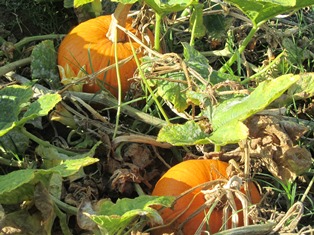
Pumpkins in my garden sport golden shades of orange and yellow, signalling arrival of the cool season
As the sun slants lower in the sky giving us shorter days, less light, and fewer hours to garden, there are some plants that will grow just fine during the cool days of fall.
However, you must select the right plants for the cool season. In addition, you’ll increase your plants’ survival rate by growing them in raised beds and boxes with good soil and aged manure. Wet them well if a cold front comes through (it’s counter-intuitive but moisture will protect their roots). Keep them warm at night with plant covers that you take off during the day when they can make the most of the sun’s warmth and light.
Consider growing some of these cool season crops: beet, bok choy, broccoli, bulb onion, chard, fava bean, garlic, green onion, kale, kohlrabi, lettuce, radish, spinach, and turnip. I’ve found many of these plants available at my local DIY garden center during the past two weeks.
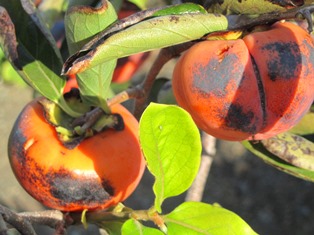
Coffee Cake, a new variety of Fuyu persimmon I’m growing will soon be ripe for picking, slicing, and serving
For November, depending on weather conditions in local microclimates, Northern California gardeners can grow fava bean, garlic, greens, leek, lettuce, onion, pea, radish, and spinach as well as some perennial herbs, especially in boxes and/or pots on the patio or in protected places such as porches.

My pumpkin vines, over 25 feet long, still have numerous blooms and lemon-size green pumpkins hanging on
Because of Northern California’s mild Mediterranean climate, gardeners can enjoy cultivating plants from spring through the fall, not just during our hot summer months. If it gets too chilly for the poor honeybees to pollinate, get yourself a soft watercolor brush and do the pollination yourself.
Finally, it’s worth noting that during our rainy season, the water for the garden falls from the sky rather than from the hose. One of the many reasons not to put away the garden tools just yet.
Cool Season Plantings for Soup, Salad, and Pie
This time of year the French sugar pumpkins, persimmons and pomegranates are ready to harvest and that means it’s also time to plant cool season crops.

My summer onions formed large bulbs that I have already harvested; it’s time to replace them with bunching onions
Yesterday I turned the dirt in one of my large planting boxes, added in some aged manure and other soil amendments, and planted red and yellow onions for soups and salads during the fall and winter. I harvested seed from my summer onions and during the winter months will grow the seed in flats for spring planting.
The cool days ahead are perfect soup days and that means carrots, fennel, cilantro, cauliflower, potatoes, and bok choy will also find a place in my fall and winter garden.
In other raised beds and boxes, I’m planting heirloom lettuces, radishes, and spinach. These traditional salad ingredients are best grown during the fall or early spring as hot weather tends to make them bolt.
The pumpkins are ready for pie-making and Halloween carving. The persimmons are perfect for custards or for eating fresh when absolutely ripe (otherwise, the fruits are so tart they will make you pucker). And those lovely red pomegranate seeds are delicious eaten raw or tossed into salads.
For a list of Northern California cool seasons vegetables, check out Sunset Magazine’s edible gardening guide at http://www.sunset.com/garden/garden-basics/cool-season-crops-00400000042441/. If you plant to purchase seed f0r your own cool season garden, I urge you to choose non-genetically modified and open-pollinated seeds so that you can harvest.
 Facebook
Facebook Goodreads
Goodreads LinkedIn
LinkedIn Meera Lester
Meera Lester Twitter
Twitter




